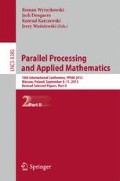Abstract
Angiogenesis is the process of formation of vascular network. Blocking tumour induced angiogenesis is one of the treatments applied in oncology. Research involving computer simulations looking for the rules influencing the structure of vascular network and its functionality. This paper summarizes the applications of Graph of Cellular Automata modelling tool, developed by the Author, for modelling Tumour Induced Angiogenesis. Vascular network which is modelled by the graph interacts with surrounding tissue represented by the lattice of automata. The network is developed and reorganized accordingly to locally acting factors (stimulators and inhibitors). The model includes blood flow calculations in a modelled vascular network.
Access this chapter
Tax calculation will be finalised at checkout
Purchases are for personal use only
References
Carmeliet, P.: Angiogenesis in life, disease and medicine. Nature 438, 932–936 (2005)
Mantzaris, N., Webb, S., Othmer, H.G.: Mathematical modeling of tumour-induced angiogenesis. J. Math. Biol. 49(2), 111–187 (2004)
Rew, D.A.: Modelling in tumour biology part 1: modelling concepts and structures. Eur. J. Surg. Oncol. 26(1), 87–94 (2000)
Bergers, G., Song, S.: The role of pericytes in blood-vessel formation and maintenance. Neuro-oncology 7(4), 452–464 (2005)
Topa, P., Dzwinel, W., Yuen, D.: A multiscale cellular automata model for simulating complex transport systems. Int. J. Mod. Phys. C 17(10), 1–23 (2006)
Topa, P.: Towards a two-scale cellular automata model of tumour-induced angiogenesis. In: El Yacoubi, S., Chopard, B., Bandini, S. (eds.) ACRI 2006. LNCS, vol. 4173, pp. 337–346. Springer, Heidelberg (2006)
Topa, P.: Dynamically reorganising vascular networks modelled using cellular automata approach. In: Umeo, H., Morishita, S., Nishinari, K., Komatsuzaki, T., Bandini, S. (eds.) ACRI 2008. LNCS, vol. 5191, pp. 494–499. Springer, Heidelberg (2008)
Byrne, H., Chaplain, M.A.J.: Mathematical models for tumour angiogenesis: numerical simulations and nonlinear wave solutions. Bull. Math. Biol. 57, 461–486 (1995)
Anderson, A.R., Chaplain, M.A.: A mathematical model for capillary network formation in the absence of endothelial cell proliferation. Appl. Math. Lett. 11(3), 109–114 (1998)
Plank, M.J., Sleeman, B.D., Jones, P.F.: A mathematical model of tumour growth, regulated by vascular endothelial growth factor and the angiopoietins. J. Theor. Biol. 229, 435–454 (2004)
Anderson, A.R., Chaplain, M.A.: Continuous and discrete mathematical models of tumour-induced angiogenesis. Bull. Math. Biol. 60, 857–900 (1998)
Lowengrub, J.S., et al.: Nonlinear modelling of cancer bridging the gap between cells and tumours. Nonlinearity 23(1), R1–R96 (2010)
Macklin, P., et al.: Multiscale modelling and nonlinear simulation of vascular tumour growth. J. Math. Biol. 58, 765–798 (2009)
Stokes, C.L., Lauffenburger, D.A.: Analysis of the roles of microvessel endothelial cell random motility and chemotaxis in angiogenesis. J. Theor. Biol. 152, 377–403 (1991)
Anderson, A.R.A., Pitcairn, A.: Application of the hybrid discrete-continuum technique. In: Alt, W., et al. (eds.) Polymer and Cell Dynamics-Multiscale Modeling and Numerical Simulations, pp. 261–279. Birkhauser, Basel (2003)
Owen, M.R., Alarcón, T., Byrne, H.M., Maini, P.K.: Angiogenesis and vascular remodelling in normal and cancerous tissues. J. Math. Biol. 58(4), 689–721 (2009)
McDougall, S.R., et al.: Mathematical modelling of flow through vascular networks: implications for tumour-induced angiogenesis and chemotherapy strategies. Bull. Math. Biol. 64(4), 673–702 (2002)
Topa, P., Dzwinel, W.: Using network descriptors for comparison of vascular systems created by tumour-induced angiogenesis. Theor. Appl. Inf. 21(2), 83–94 (2009)
Acknowledgements
This research is partially supported by AGH-University of Science and Technology grant No. 11.11.230.015.
Author information
Authors and Affiliations
Corresponding author
Editor information
Editors and Affiliations
Rights and permissions
Copyright information
© 2014 Springer-Verlag Berlin Heidelberg
About this paper
Cite this paper
Topa, P. (2014). The Graph of Cellular Automata Applied for Modelling Tumour Induced Angiogenesis. In: Wyrzykowski, R., Dongarra, J., Karczewski, K., Waśniewski, J. (eds) Parallel Processing and Applied Mathematics. PPAM 2013. Lecture Notes in Computer Science(), vol 8385. Springer, Berlin, Heidelberg. https://doi.org/10.1007/978-3-642-55195-6_67
Download citation
DOI: https://doi.org/10.1007/978-3-642-55195-6_67
Published:
Publisher Name: Springer, Berlin, Heidelberg
Print ISBN: 978-3-642-55194-9
Online ISBN: 978-3-642-55195-6
eBook Packages: Computer ScienceComputer Science (R0)

